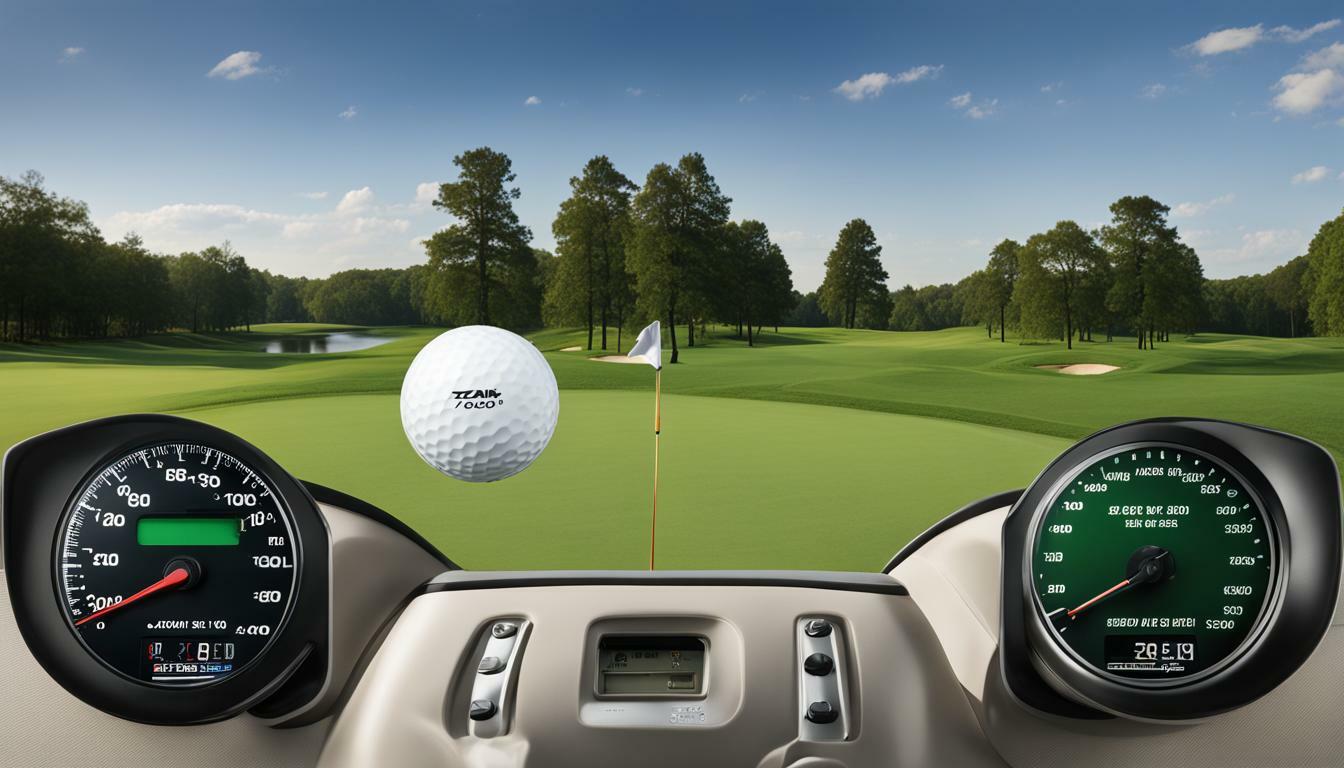Golf is a sport that requires precision, accuracy, and good technique. One of the most important aspects of golf is the speed at which the ball travels. Understanding how fast a golf ball travels can help you optimize your swing and improve your overall performance on the course.
In this article, we will explore the various factors that affect golf ball speed and examine the maximum velocity a golf ball can reach.
So, how fast does a golf ball travel? The answer depends on several factors, including the clubhead speed, launch angle, and dimple design. Each of these elements can influence the average distance a golf ball can travel and, ultimately, its speed.
Key Takeaways
- Understanding the speed at which a golf ball travels is crucial for enhancing your performance on the course.
- The speed of a golf ball is influenced by various factors, including clubhead speed, launch angle, and dimple design.
- By optimizing your swing and considering these factors, you can enhance your ball speed and achieve greater distance on your shots.
Factors Affecting Golf Ball Speed
The speed at which a golf ball travels is a crucial factor in the game of golf. Your ability to hit a ball with great speed can significantly impact the distance it travels, allowing you to reach your target more efficiently. To achieve great ball speed, you must understand several key factors that can affect the speed of a golf ball.
Clubhead Speed
The speed at which you swing your club has a direct impact on the speed of the ball. Faster clubhead speeds result in more energy being transferred from the club to the ball, leading to greater ball speed and distance. By improving your swing technique and increasing your clubhead speed, you can maximize your ball speed and achieve greater consistency in your shots.
Launch Angle
The angle at which a golf ball is hit also influences its speed and distance. A high launch angle can result in greater ball speed and distance, while a low launch angle can limit the ball’s overall distance. By adjusting your swing and club selection to achieve the optimal launch angle, you can maximize the distance your ball travels on the course.
Dimple Design
The dimple design of a golf ball plays a crucial role in its speed and distance. The dimples on the ball create turbulence in the air, reducing drag and allowing the ball to fly farther. Golf balls with more significant dimples or a unique dimple pattern tend to travel farther than those with fewer or smaller dimples. Understanding the impact of dimple design can help you select the right ball for your swing and optimize your performance on the course.
By considering these key factors, you can enhance your golf game and achieve greater ball speed and distance. Understanding and optimizing your swing technique, launch angle, and ball selection can help you become a more consistent and successful player on the course.
Maximum Velocity of a Golf Ball
Have you ever wondered just how fast a golf ball can travel? It turns out that the current speed record for a golf ball hit in competition is a whopping 211 mph! This incredible feat was accomplished by Ryan Winther in 2013 at the World Long Drive Championship.
To put that into perspective, the average speed of a golf ball hit by a professional golfer is around 160-170 mph, while the average speed for an amateur golfer is much lower, at around 120 mph. Of course, there are many factors that can affect the speed of a golf ball, including the golfer’s swing speed, the launch angle of the ball, and the design of the ball itself.
| Equipment | Speed |
|---|---|
| Driver | Between 120-150 mph |
| Iron | Between 70-100 mph |
The type of equipment used can also impact the maximum velocity of a golf ball. Drivers, which are designed for long-distance shots, tend to have a larger sweet spot and a larger clubface, allowing for greater ball speed. In contrast, irons are designed for more precision shots and have a smaller sweet spot and clubface, resulting in lower ball speed.
The key to achieving high velocities is a combination of equipment and technique. Golfers who want to increase their ball speed should focus on optimizing their swing, improving their launch angle, and properly selecting the right equipment for their skill level. Remember, speed is only one part of the equation – accuracy and consistency are also crucial for success on the course.
Achieving Long Distance Shots
When it comes to hitting long distance shots in golf, it’s not just about swinging harder. There are a variety of factors that can impact how far the ball will travel, and by optimizing these elements, you can achieve greater distances and improve your overall performance on the course.
Swing Mechanics
Having proper swing mechanics is crucial for hitting long distance shots. One of the most important elements to focus on is your clubhead speed. The faster you can swing the club, the more power you’ll be able to transfer to the ball. However, it’s important to maintain control and accuracy, so make sure you’re not sacrificing good form for speed.
Additionally, your swing path and angle of attack can also impact the distance of your shot. A more upward angle of attack can produce a higher launch angle and more distance, while a flatter angle of attack can cause the ball to travel lower and farther.
Club Selection
Choosing the right club can also play a big role in achieving long distance shots. Generally, clubs with lower lofts (such as drivers and fairway woods) are better for longer shots, as they’ll produce a lower trajectory and more roll on the fairway. However, it’s important to choose a club that you feel comfortable with and can consistently hit accurately.
Shot Trajectory
The trajectory of your shot can have a significant impact on its distance. A higher trajectory will typically result in a shorter carry but more overall distance, while a lower trajectory will produce more roll on the fairway but less overall distance. Experiment with different shot trajectories to see what works best for your swing and the course conditions.
By focusing on these key elements, you can improve your long distance shots and take your golf game to new heights. Remember to also practice consistently and maintain good overall physical fitness to ensure optimal performance on the course.
Achieving Long Distance Shots
So, you want to hit long-distance shots? Here are some tips and strategies to help you achieve greater ball speed and cover more ground on the course.
Optimize Your Swing Mechanics
First and foremost, your swing mechanics play a critical role in hitting long-distance shots. Focus on achieving a balanced and smooth swing, with a consistent tempo and timing. This will allow you to generate more clubhead speed and translate that energy into ball speed.
Additionally, pay attention to your grip and stance. Make sure your grip is firm but not too tight, and align your feet with your target for optimal trajectory and power.
Select the Right Club
Choosing the right club can also make a significant difference in your shot distance. Use a club with a lower loft angle, such as a driver or fairway wood, to generate more speed and distance. However, be mindful of your accuracy and control with these clubs, as they can be harder to use for precise shots.
Adjust Your Shot Trajectory
The trajectory of your shot can also impact your distance. Aim to launch the ball high and with a slight draw, as this will help maximize your carry distance and roll on the fairway. Experiment with different ball positions and shoulder angles to find the right trajectory for your swing.
By incorporating these tips and strategies into your game, you can increase your ball speed and hit longer shots on the course. Remember, practice makes perfect, so keep refining your technique and pushing your limits. Good luck!





Leave a Reply